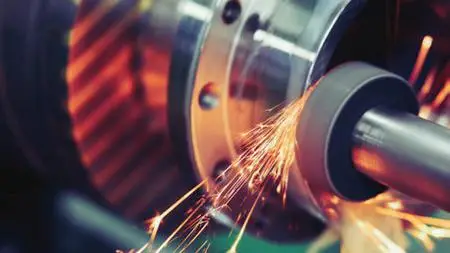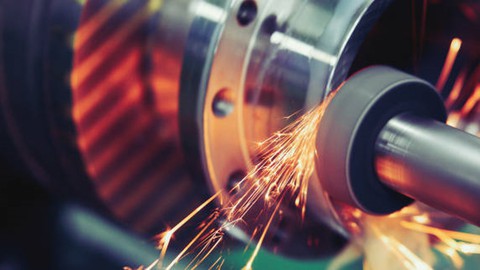Fundamentals of Manufacturing Materials, Processes & Systems
Genre: eLearning | MP4 | Video: h264, 1280x720 | Audio: AAC, 44.1 KHz
Language: English | Size: 7.21 GB | Duration: 17h 58m
Genre: eLearning | MP4 | Video: h264, 1280x720 | Audio: AAC, 44.1 KHz
Language: English | Size: 7.21 GB | Duration: 17h 58m
18 Hours Course to Understand the Industrial Manufacturing Processes for Plastics and Metals and Joining of Metals 2022
What you'll learn
Discuss in detail the manufacturing processes of metallic and plastic parts.
Compare between different types of metal forming processes and differentiate between their output product.
Describe different types of joining process and introduce the concept of sustainable manufacturing.
Recognize, understand and develop working knowledge of broad range of manufacturing processes that are used in the industry.
To compare the existing technologies used in casting, shaping, forming, property enhancing, joining and assembly process.
To learn how component can be manufactured in sustainable manner and learn about the environmental hazards of different manufacturing processes.
Apply appropriate manufacturing processes for a product and determine its parameters.
Analyze process dynamics and performance of different manufacturing processes.
Description
This course provides an introduction to the manufacturing processes that are used in industry to manufacture products that are widely used in daily life.
Introduction to Manufacturing: Types of manufacturing industries, materials used in manufacturing and properties of materials, different processing operation.
Sand Casting
Introduction: Sand casting, molding, heating, pouring, solidification, and cooling. Pattern: making, material, types, construction, pattern allowances.
Core: making, types, sand conditioning, testing of the sand, molding process, tools and equipment, molding machines, different types of casting, cleaning and finishing of castings, an inspection of castings.
Permanent Mold Casting (PMC): Introduction, types of PMC, gravity die casting, and its types. Pressure die casting, Centrifugal casting, and their types. Furnaces used in PMC.
Metal Forming
Fundamentals, Types, hot, warm, and cold working.
Bulk Deformation Processes
Rolling; rolled products, rolling types: flat, shape, thread, gear, ring rolling, and rolling mill configurations.
Forging; open die, impression die, press, upset, roll, net shape, isothermal forging and swaging.
Extrusion; solid & hollow shapes, direct & indirect, hot & cold, continuous & discrete, impact extrusion, hydrostatic.
Drawing; bar, wire, tube drawing and its types tike tube sinking, fixed mandrel, floating plug.
Other metal forming processes; roll extrusion, riveting, staking, peening, coining, hubbing, burnishing.
Sheet metal forming processes: Shearing operations: slitting, blanking, piercing, cutoff, parting, dinking, slotting, perforating, notching, semi-notching, lancing, nibbling, trimming, shaving, fine blanking. Bending operations: V bending, edge bending, flanging, curling, hemming, seaming. Drawing operations like deep and shallow drawing, embossing.
Welding Processes: Classification, Fusion welding and its types such as oxyfuel gas welding and oxygen torch cutting, arc welding (shielded metal, flux-cored, gas metal, submerged, gas tungsten, plasma, stud welding, Arc cutting), resistance welding (spot, seam and projection. Heating, pressure, current control and power supply for resistance welding).
Solid-state welding and its types include diffusion welding, friction welding, and ultrasonic welding.
Other welding processes: Forge, Roll, Friction, Explosion, Thermic, Electron beam, Laser welding and cutting, Brazing and Soldering.
Fabrication of Plastics: Casting, Blow molding and its types, Compression molding, Transfer molding, Cold molding, Injection molding: Injection molding machine, mold design, and construction, types of mold, cooling and ejection of mold, Reaction injection molding, Welding of plastics.
In the end, there are videos that are videos related to the course for better understanding.
Course Outline
Introduction to Manufacturing
Lecture 1
Introduction to Manufacturing Processes
What is manufacturing
Manufacturing Industries
Manufacturing Products
Production Quantity and Product variety
Materials in Manufacturing
Manufacturing Processes (Processing operations and Assembly operations)
Sand Casting
Lecture 2
Overview of casting technologies
Difference between casting and molding
Advantages and Disadvantages of casting processes
Casting Processes (Expendable mold casting and permanent mold casting)
Lecture 3
Sand casting and Engineering analysis of sand casting y sand
Pouring and Engineering Analysis of Pouring
Flow rate and time required to fill the mold
Fluidity
Solidification and Cooling
Lecture 4
Solidification of pure metals and alloys (Alloys and Eutectic Alloys)
Solidification time and Shrinkage
Directional Solidification
Lecture 5
Riser Design with Exercise Problems.
Lecture 6
Pattern for casting
Materials used for pattern
Types of pattern
Mold making and Classification of sand molds
What is foundry sand?
Lecture 7
Buoyancy Force
Metal casting processes
Shell molding
Advantages and Disadvantages of Shell molding
Vacuum molding
Advantages and Disadvantages of Vacuum molding
Expanded Polystyrene Casting
Advantages and Disadvantages of Expanded Polystyrene Casting
Investment casting
Plaster and Ceramic Mold casting
Permanent Mold Casting (PMC)
Lecture 8
Types of pattern allowance (Shrinkage and contraction allowance, Draft allowance, Machining allowance, and Distortion allowance)
Permanent mold casting and its Applications.
Slush casting
Low-pressure casting
Vacuum permanent mold casting
Die casting (Hot and cold chamber die casting)
Advantages and Limitations
Centrifugal casting and Semi centrifugal casting
Lecture 9
Furnaces
Cupolas Furnace
Direct Fuel Fired Furnace
Crucible Furnace
Electric Arc Furnace
Induction Furnace
Metal Forming
Lecture 10
Fundamentals of metal forming
Types of deformation processes of metal
Bulk deformation (Rolling, Forging, Extrusion, Wire Drawing)
Sheet metal working
Stress-Strain Curve
Derivation of the relation between stress and strain
Flow stress and Average flow stress
The temperature in metal forming (Cold working and Hot-working)
Recrystallization
Iso thermal forming (recovery and Grain growth)
Strain rate Sensitivity
Lecture 11
Introduction of rolling
Shapes used for rolling
Types of rolling
Working of the rolling process
Analysis of the rolling
Rolling mills
No-Slip Point for rolling
Flatness control and rolling defect
Lecture 12
Numerical Problems related to the rolling process
Lecture 13
Introduction to forging
Classification of forging
Types of forging
Analysis of the forging
Barreling effect in forging
Open Die forging and its practices
Impression Die forging and its practices
Advantages and Limitations of Impression Die forging
Fleshless forging
Forging Press and Forging Hammers
Lecture 14
Numerical Problems related to the forging process
Lecture 15
Introduction to the extrusion process
Classification of extrusion
Direct and Indirect extrusion
Hot and Cold extrusion
Direct and Continuous extrusion
Analysis of the extrusion process
Effect of friction on extrusion
Extrusion Dies and Orifice
Extrusion press and other extrusion processes
Lecture 16
Numerical Problems related to the extrusion process
Introduction to Drawing
Difference between drawing and wire drawing
Bar Drawing
Wire Drawing
Features of Draw Die
Preparation of the work
Analysis of the drawing process
Sheet metal forming processes
Lecture 17
Introduction to sheet metal cutting process
Characteristics of Edges
Types of sheet metal cutting
Shearing
Blanking and Punching
Clearance in Sheet metal cutting
Analysis of sheet metal cutting processes
Numerical Problems related to the sheet metal cutting process
Lecture 18
Introduction of sheet metal bending process
Types of sheet metal bending
Analysis of the sheet metal bending process
Numerical Problems related to the sheet metal bending process
Spring Back
Lecture 19
Introduction to the drawing process
Mechanics of drawing
Stages of deformation
Analysis of the drawing process
Tests of Drawing Feasibility
Blank force and blank size determination
Numerical Problems related to the drawing process
Lecture 20
Other drawing processes (Redrawing, Reverse Drawing and Drawing without Blank holder)
Defects in Drawing
The operation performed with metal tooling
Ironing
Coining & Embossing
Lancing & Twisting
The operation performed with flexible Rubber tooling
Guerin and Hydro forming process
Lecture 21
Numerical Problems related to the other drawing processes
Welding Processes
Lecture 22
Fundamentals of welding
Difference between joining and welding
Advantages and Disadvantages of Welding
History of welding
Types of the welding process
Components used for welding process (Filler material, Flux, and Electrolyte)
Consumable and Non-consumable electrolyte
Welding positions
Welding Electrode Nomenclature
Type of Weld Joints (Butt joint, Corner Joint, Lap joint, Tee Joint, Edge Joint)
Types of Weld (Filler Weld, Groove Weld, Plug weld or slot weld, Spot and Seam weld, Flange and Surface Weld)
Features of Fusion Welded Joints
Physics of welding (Power Density and Numerical of Power Density)
Heat Balance in Fusion Welding
Welding as Commercial Operation
Automation in Welding (Machine, Automatic and Robotic)
Welding Safety
Lecture 23
Welding Categories (Fusion Welding, Solid State Welding, Soldering and Brazing)
Arc Welding
Arc Shielding
The power source in Arc welding
Types of Arc Welding (Shielding metal arc welding, Gas Metal Arc Welding, Flux Cored Arc Welding, Submerged Arc Welding,
Gas Tungsten welding
Plasma arc welding
Lecture 24
Oxyfuel arc welding
Oxyacetylene welding
Resistance welding
Spot Welding
Resistance seam welding
Resistance projection welding
Energy beam welding (Electron beam welding, Laser beam welding)
Numerical Problems related to the welding processes
Lecture 25
Numerical Problems Related to the welding processes
Lecture 26
Solid-state welding
Types of solid-state welding
(Diffusion welding, Friction welding, and Ultrasonic welding)
Welding Defects of Solid State Welding
Brazing and Soldering
Fabrication of Plastics
Lecture 27
Plastics
Type of Plastics
Properties of polymer melt (Viscosity and Viscoelasticity)
Extrusion process for Plastics in detail
Extruder Screw
Feed Section
Compression Section
Metering Section
Process Parameters
Solid and Hollow Profiles
Wire and Tube coating
Defects in the extrusion process
Lecture 28
Injection molding for Plastics in detail
Clamping
Injection
Cooling
Ejection
Application and Material
Advantages and Disadvantages
Lecture 29
Blow Molding
Extrusion Blow Molding
Injection Blow Molding
Stretched Blow Molding
Compression Molding
Transfer Molding (A pot transfer molding and B plunger-type transfer molding)
OZIS Academy is the best platform for struggling students and professionals who want to improve their skills for the workfield as it provides a large no of quality and detailed courses. We offer courses from brilliant Ph.D. Professors from prestigious Universities who are experts in their relative fields. We have a team of well-experienced, full-time faculty and dedicated staff including talented retired and working University professors. Our mission is to impart most qualitative education by the way of systematic methodical and scientific approaches.
Visit our WEBSITE to get limited-time FREE & DISCOUNT COUPONS for our Udemy Courses
Who this course is for
ll concepts are introduced slowly and gradually, but comfort with thinking analytically will be helpful.
Engineering students and professionals who want to level up their skills.
Engineers in Mechanical, Manufacturing, Industrial, Electrical and other related fields looking for a way out of traditional processes for their projects and products.
Anyone starting their career in the manufacturing and production world.



